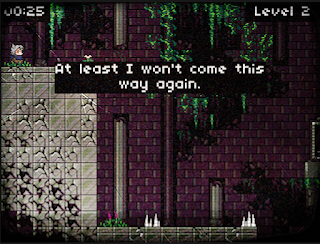Pause Ahead
(available on AdultSwim, NewGrounds, and Game Jolt)
Pause Ahead is an indie platformer developed by aSkillSoft, the makers of Tower of Heaven. Like their other title, this game is hard. There is no exception. The difficultly curve is quite steep yet it's fun to play. Why is that? Well, as soon as the mechanics are to get the player accustomed to the gameplay, the game then challenges the player to make split second decisions to figure out how to get the next stage. Having an adorable character and a kickass soundtrack doesn't hurt either.
So, we start off with the simple jump [Space] mechanic in a safe slow environment with an introduction to the timer. If the timer runs out the player will burst into flames. Pretty harsh. During Level 2 of the tutorial, he player is introduced to the second enemy; stationary spikes. Exciting. When a player hits an enemy the player automatically explodes! These quick negative responses are really jarring. There's no lives, no score, no forced game overs... unless you rage quit.
Oh! Possible story! I really like these little tidbits of information as I played the game. Has the character been here before? Maybe the developer is hinting that we will use the same mechanics as before in a more difficult situation. Each blurb comes up in the beginning of the stage and quickly disappears after you start moving to reduce distractions. Look at those saws! Spikes on the ceiling! Watch out. New ways to blow up and die.
Oh? Cheeky really. When you pass a level, it does a reply of all of your collective deaths. I can't tell whether it is satisfying or upsetting to see all of my failed performances while I finally stand at the finish line. I really do admire the pacing of the game levels. They give little information at a time so the player can focus on one enemy situation at a time.
We are then introduced to more enemies. This time, these falling rock enemies which heavily represent "Thwomps" from Mario who haven't had sleep for days. These little guys on the right fall in a cascading motion, which follow the larger brother version but with a little flair.
Now for the most important mechanic of them all: The Pausing.
Whats the appeal of playing this and why is tutorial good?
The game introduced the player to simple mechanics then throws them into a extremely unforgiving environment. The gameplay looks and seems simpler than it is. The key is that it's all about timing the pause and creating intricate ways to get to the door before the timer runs out. The cute main character, amazing soundtrack, easy mechanics really push the playability in this cruel, cruel game. Also, it's free to play!
Whats rewarding? The player is given the jumping mechanic and pausing at their disposal with fun tidbits of info/story in the beginning of the stage. The player watches their death reel of all the attempted tries and laughs at their failures.
What's a negative response to the player? The player is faced with several environment enemies (Time, spikes, thwomp guys and variations) as well as their own terrible decision making. The player is immediately scolded when he or she does the wrong move and has to start from the beginning. The player watches their death reel at the attempted tries and sulks at their terrible skills.
What about the level design helps the player feel engaged and challenged? Each level is constructed differently depending on what is introduced and what is to be completed. For the times where learning a mechanic is crucial to progress in the game, the level has more time to complete and the level information is given to the player upfront. When there is a minor mechanic, enemy, or twist given to the player, the level is much more hidden. This leaves the player battling with the complexity of the level design as she or he progresses throughout the game.
What about the level design helps the player feel engaged and challenged? Each level is constructed differently depending on what is introduced and what is to be completed. For the times where learning a mechanic is crucial to progress in the game, the level has more time to complete and the level information is given to the player upfront. When there is a minor mechanic, enemy, or twist given to the player, the level is much more hidden. This leaves the player battling with the complexity of the level design as she or he progresses throughout the game.
Here are the Tutorial Levels 1-5 into a vector map
for your linear viewing pleasure








No comments:
Post a Comment